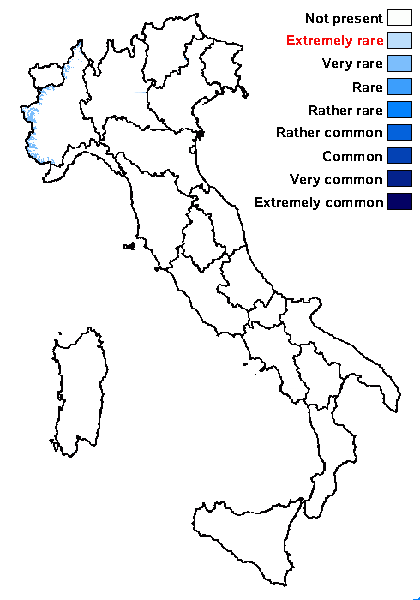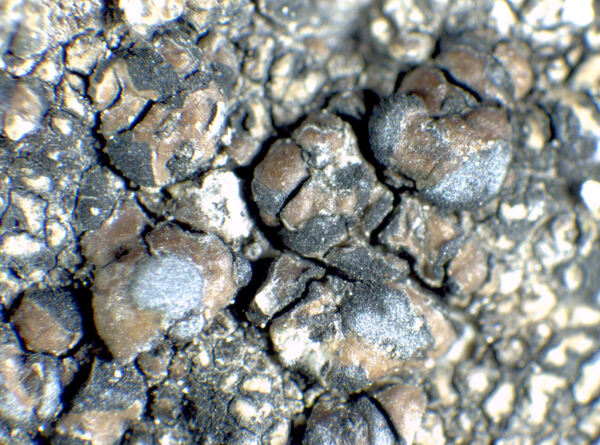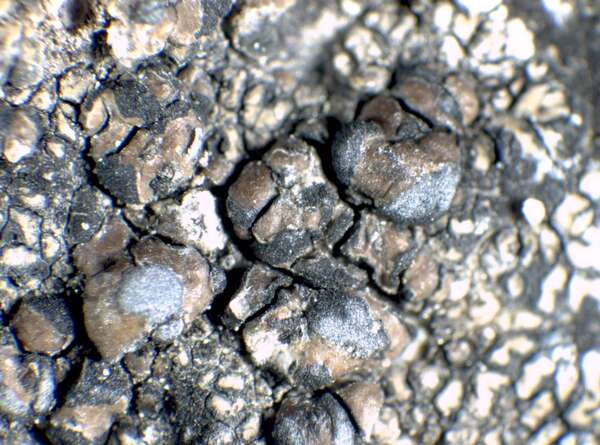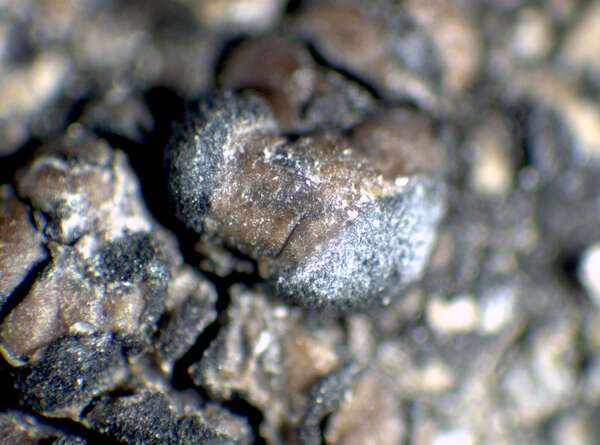Protoparmelia leproloma (R. Sant.) Rambold & Poelt
in Poelt & Leuckert, Nova Hedwigia, 52: 54, 1991 comb. inval.. Basionym: Lecidea leproloma R. Sant. - Sched. ad Lich. Sel. Upsal.: 14, 1986.
Synonyms:
Distribution: N - Piem (TSB 34093).
Description: Thallus crustose, episubstratic, areolate-subsquamulose, forming 3-7(-15) mm wide patches on the thalli of Lecidea paupercula, without a distinct prothallus. Areoles subpeltate, slightly concave to flat, smooth, yellowish brown to blackish brown, 0.2-0.7(-1.2) mm across, 0.1-0.4 mm thick, each one surrounded by a 0.1-0.2 mm wide, bluish black margin formed by 7-9 µm thick, warty, branched, 5-8 µm wide hyphae producing (1-)2-3-celled thalloconidia measuring 10-12 x c. 7 µm, with irregularly arranged rounded, warty, bluish black cells, N+ dark purple. Apothecia extremely rare, lecanorine, adnate, with a brown disc and a thin, not prominent thalline margin. Exciple brown, pseudoparenchymatous; hymenium colourless; paraphyses coherent, simple or sparingly branched, thick, the apical cells slightly swollen; hypothecium colourless. Asci 8-spored, clavate, approaching the Lecanora-type, with a well-developed amyloid tholus and a distinct, non-amyloid axial mass. Ascospores 1-celled, hyaline, ellipsoid, thin-walled, 8-11 x 5-7 µm. Photobiont chlorococcoid. Spot tests: cortex and medulla K-, C-, KC-, P-. Chemistry: stictic, norstictic and cryptostictic acid (mostly in traces). Note: an arctic-alpine silicicolous species which starts the life-cycle on other lichens (Lecidea paupercula, more rarely Sporastatia and other crustose lichens), more widespread in Scandinavia than in the Alps, where it occurs above treeline. The species does not belong to Protoparmelia s.str.
Growth form: Crustose
Substrata: rocks
Photobiont: green algae other than Trentepohlia
Reproductive strategy: mainly asexual, by thallus fragmentation
paras
Commonnes-rarity: (info)
Alpine belt: very rare
Subalpine belt: absent
Oromediterranean belt: absent
Montane belt: absent
Submediterranean belt: absent
Padanian area: absent
Humid submediterranean belt: absent
Humid mediterranean belt: absent
Dry mediterranean belt: absent

Predictive model
Herbarium samples
Growth form: Crustose
Substrata: rocks
Photobiont: green algae other than Trentepohlia
Reproductive strategy: mainly asexual, by thallus fragmentation
paras
Commonnes-rarity: (info)
Alpine belt: very rare
Subalpine belt: absent
Oromediterranean belt: absent
Montane belt: absent
Submediterranean belt: absent
Padanian area: absent
Humid submediterranean belt: absent
Humid mediterranean belt: absent
Dry mediterranean belt: absent

Predictive model
| Herbarium samples |
 INDEX FUNGORUM
INDEX FUNGORUM
 GBIF
GBIF





